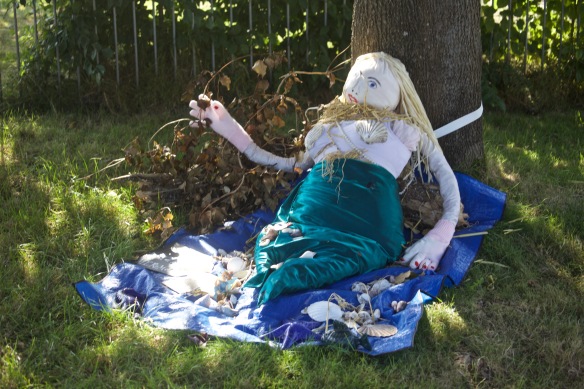CLICK ON IMAGES TO ENLARGE. REPEAT IF REQUIRED.
Today was one for Jackie to water her babies, and for me to dead-head the Rose Garden.
We have many dahlias enhancing various beds;
and rudbeckia, canna lilies, Japanese anemones, and buddleia blending in the Palm Bed.
This afternoon we hit the Hordle Scarecrow Trail once more.
Entry No. 1, at 9, Longfield Road, is a commendable Junior effort. ‘Alice in Wonderland’ is embellished by the Cheshire Cat in the window.
A number of Individual competitors have chosen to portray ‘Rapunzel’. No. 2 at 33 Longfield Field road has set the heroine in her castle prison, with her hair trailing along the shrubbery;
at 8, Myrtle Close, entry number 10, she resembles a lengthy caterpillar snaking along the top of the fence;
No.7, at Rose Cottage, Woodcock Lane is an imaginative junior entry. The castle has been incorporated, and the eponymous character hangs out of the window.
‘Three Little Pigs’, No.4, at 152 Everton Road tells the story to which I referred in ‘The Uses of Enchantment’.
There are two ‘Pinocchio’s. 3, White Barn Crescent houses entry number 5;
no.6 at 3, Mallard Close, also features Jiminy Cricket. This excellent piece of work was an Anglo-Canadian collaboration, in that the creator’s Canadian grandchildren had a big hand in the operation. Making Pinocchio a puppet on strings is a splendid touch.
‘The Wizard of Oz’ at 62, Everton Road, entry number nine, is interactive. Not content with three-dimensional references to L. Frank Baum’s story, Robert Gill has provided a witch on the gatepost. If you dare to press the button you will get a scare.
You could easily miss parts of entry number 8 at Beehive Cottage, 86B Everton Road. Firstly, why ‘Crow White’? Surely she is ‘Snow White’? Not if she’s a scarecrow, she isn’t.
Then, she bemoans lack of help with the housework.
If you look up to the bedroom window you will see the wicked stepmother reflected in her mirror;
but unless you investigate the Land Rover parked in front of the garage, you won’t see the ugly old woman into whom she was transformed, with the poisoned apple on the dashboard. It was useful to have my Driver’s extra pair of eyes to take in all this.
Looking decidedly out of her element was ‘The Little Mermaid’, the Hordle W.I. entry number 12.
This evening we dined on roast beef, new potatoes, cauliflower, carrots, and green beans, with scrumptious gravy. I finished the Fleurie, and Jackie drank Hoegaarden.

























